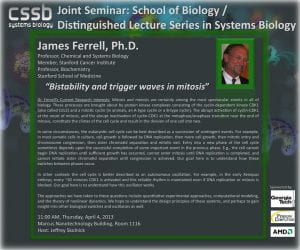 Distinguished Lecture Series Guest Speaker: James Ferrell, Jr.
Distinguished Lecture Series Guest Speaker: James Ferrell, Jr.
Professor, Chemical and Systems Biology
Member, Stanford Cancer Institute
Professor, Biochemistry
Stanford University School of Medicine
Date & Time: Tuesday, April 4, 2013, 11:00AM
Location: Marcus 1116
Host: Jeffrey Skolnick
Additional Info: Dr. Ferrell’s Current Research Interests: Mitosis and meiosis are certainly among the most spectacular events in all of biology. These processes are brought about by protein kinase complexes consisting of the cyclin-dependent kinase CDK1 (also called Cdc2) and a mitotic cyclin (in animals, an A-type cyclin or a B-type cyclin). The abrupt activation of cyclin-CDK1 at the onset of mitosis, and the abrupt inactivation of cyclin-CDK1 at the metaphase/anaphase transition near the end of mitosis, constitute the climax of the cell cycle and result in the division of one cell into two.
In some circumstances, the eukaryotic cell cycle can be best described as a succession of contingent events. For example, in most somatic cells in culture, cell growth is followed by DNA replication, then more cell growth, then mitotic entry and chromosome congression, then sister chromatid separation and mitotic exit. Entry into a new phase of the cell cycle sometimes depends upon the successful completion of some important event in the previous phase. E.g., the cell cannot begin DNA replication until sufficient growth has occurred, cannot enter mitosis until DNA replication is completed, and cannot initiate sister chromatid separation until congression is achieved. Our goal here is to understand how these switches between phases occur.
In other contexts the cell cycle is better described as an autonomous oscillation. For example, in the early Xenopus embryo, every ~30 minutes CDK1 is activated and this reliable rhythm is maintained even if DNA replication or mitosis is blocked. Our goal here is to understand how this oscillator works.
The approaches we have taken to these questions include quantitative experimental approaches, computational modeling, and the theory of nonlinear dynamics. We hope to understand the design principles of these systems, and perhaps to gain insight into other biological switches and oscillators as well.
Lab Website
Faculty Profile, Chemical & Systems Biology
Faculty Profile, Stanford
